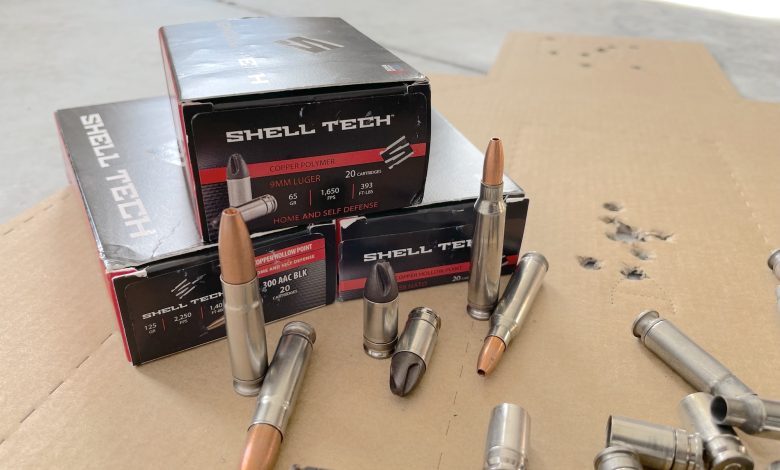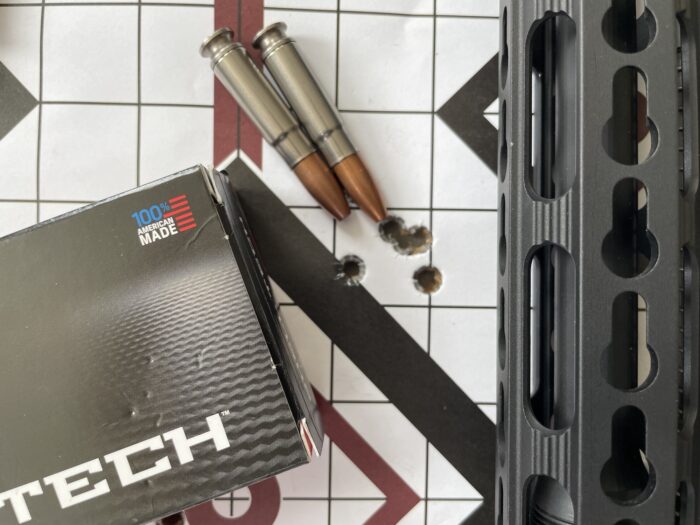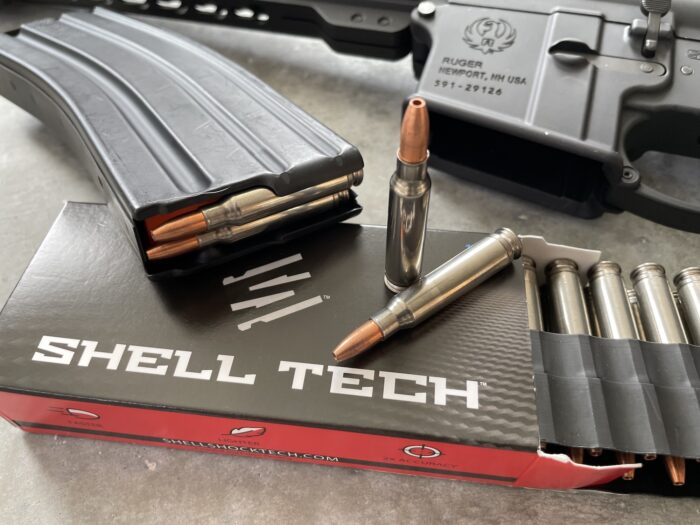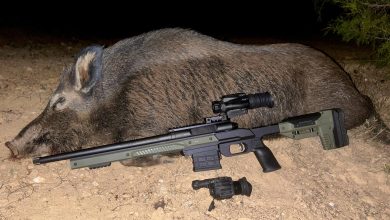Shell Tech Ammo Review: Faster, Lighter, Reliable and More Accurate

Shell Tech rifle and pistol ammunition is different. Using a two-piece case made of a stainless steel alloy body and either a stainless or aluminum base, Shell Tech is able to create ammo that is lighter, has a higher muzzle velocity, can be more accurate and more reliable with no extra wear on the gun. This is not your traditional brass case ammunition.
I know what you are thinking. We’ve all tried non-brass ammo. The inexpensive aluminum and steel case stuff that our wallet likes, but our guns don’t. It hasn’t always been a good experience. Years ago, I thought I was being smart by buying really cheap steel case 5.56 NATO from a Russian manufacturer. You know the stuff. The lacquer coating looks like Soviet snot and as sure as snot it gummed up my BCG and caused FTE (failure to eject) jams. I needed a cleaning rod to tap an empty case out of the chamber. I had better results with steel case 9mm ammo. My G17 Gen3 could have cared less what type of ammo I was using. It always went bang, and it was always excessively dirty. I learned my lesson, so when I was asked to try Shell Tech ammo, my expectation was low. What I discovered is Shell Tech ammo lives up to it claims. Shell Tech talks the talk and walks the walk. The cost of Shell Tech is comparable to brass case ammo.

The Shell Tech NAS3 case is the key. The wall thickness of the case is more uniform than brass, which means 1 to 8 percent more powder can be loaded than traditional brass. The case body also uses a flash hole that is larger in diameter so it ignites the powder more efficiently than the typical brass flash hole. You know how brass expends after being fired? The Shell Tech case doesn’t. The steel alloy is more elastic so it springs back to nearly its original size. That means no stuck cases in the chamber. It also cools faster than brass and you know how a freshly ejected brass case can feel on bare skin. The unique two-piece case design also forms a seal against both pressure and moisture while allowing higher pressure than brass. The outside of the case is slicker than nickel-plated brass, too.
For reloaders, the cases are magnetic so they are easier to be picked up and because of the stainless alloy case body, cartridges can be loaded more times than brass. Only pistol cases are reloadable, however. A special die is needed that has a spring inside the die that pushes the case out of the die, instead of pulling the case out via the base rim like traditional brass dies do.
I was provided a few boxes of Shell Tech ammo in 5.56 NATO, 300 BLK and 9mm. And the first thing I noticed was how light the 20-round boxes felt. You might not think that light weight is a useful attribute, but a micro nine stuffed with Shell Tech is noticeably lighter to carry.
Shell Tech uses bullets that are suited for training and self-defense. I used a Ruger SR-556 Takedown AR-15 that is equipped with a piston-driven system. Barrel assemblies can be swapped out, so both 5.56 NATO and 300 BLK can be fired out of the same rifle by just changing the barrel assembly. I used a S&W M&P Shield, Glock G43 and a Springfield Armory Hellcat Pro Comp to test the 9mm ammo. A Garmin Zero C1 Pro Chronograph recorded muzzle velocity and muzzle energy.
Shell Tech 5.56 NATO ammo was loaded with a 55-grain all copper hollow point bullet with factory data of 3,150 fps for muzzle velocity and 1,212 ft-lb for muzzle energy. Out of the 16-inch barrel Ruger, my lot of ammo had a muzzle velocity of 3,232 fps and 1,275 ft-lb of muzzle energy. Usually factory ammo data is higher, but in the real world, ammo clocks a lot slower.
I was surprised to see the Shell Tech ammo had a higher velocity.

I ran some Lakeshore 55-grain FMJ-BT brass case ammo just for comparison and found the Lakeshore ammo had a muzzle velocity of 2,865 fps and 1,003 ft-lb of muzzle energy. I also think the brass gods were angry at me because I had a FTF (failure to feed) issue with the brass. I had no issue feeding or ejecting the Shell Tech ammo. I used open sights and three-shot groups at 50 yards to collect accuracy data. The Shell Tech had a best group that measure 0.49 inches and an average of 0.80 inches. The Lakeshore had a best of 0.09 and averaged 1.19 inches. And it is true, the Shell Tech cases cooled more quickly than the brass.
Moving to the 300 BLK, the Shell Tech rounds were loaded with a 125-grain all copper hollow point. I swapped barrel assemblies and shot a best group that measured 0.24 inches and averaged 0.47 inches. I was happy with the results especially shooting iron sights. All the 300 BLK ammo cycled flawlessly.
Moving to the 9mm ammo, Shell Tech loaded a fluted polymer/copper 65-grain bullet. This bullet is the same length as a 124-grain FMJ bullet, so I ran some Panther 124-grain 9mm ammo against it to compare data. The Shell Tech 65-grain had a muzzle velocity of 1,505 fps and muzzle energy of 326 ft-lb out of the Springfield Armory Hellcat Pro Comp. The 124-grain Panther had a muzzle velocity of 1,101 fps and muzzle energy of 333 ft-lb out of the same pistol. Accuracy with both rounds averaged about an inch. Recoil with the Shell Tech was easy to control with the Hellcat Pro Comp. Recoil with the small Glock G43 and Shield was very controllable. I also ran the Mozambique Drill at 7 yards using the three pistols. Two shots to center of mass and one shot to the head. What surprised me was how accurate and controllable the Shell Tech ammo was out of all three pistols. The loaded weight of the pistols was noticeably less with Shell Tech ammo. Compared to a 124-grain 9mm round, the 65-grain Shell Tech round is almost half the weight. All the 9mm ammo ran with no issues.
I was very satisfied with the performance of the Shell Tech ammo. So much so that I kept seven rounds of the 9mm ammunition to use in my Glock G43 for everyday carry.

You can buy Shell Tech ammo on the Shell Tech website. You can also subscribe to receive an ammo shipment every month. Subscribing saves you 15 percent on each box of ammo. If you are dedicated to training, it makes sense to subscribe to save time and money and have ammo arrive on your door step.
Read the full article here






